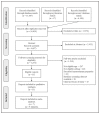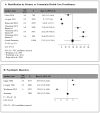Identification of Preschool Children with Mental Health Problems in Primary Care: Systematic Review and Meta-analysis
- PMID: 32405310
- PMCID: PMC7213917
Identification of Preschool Children with Mental Health Problems in Primary Care: Systematic Review and Meta-analysis
Abstract
Objective: Primary care practitioners determine access to care for many preschool children with mental health (MH) problems. This study examined rates of mental health (MH) problem identification in preschoolers within primary healthcare settings, related service use, and MH status at follow-up. The findings may inform evidence-based policy and practice development for preschool MH.
Method: For this systematic review, MEDLINE®, EMBASE®, PsycInfo®, and ERIC ® were searched from inception to March 7, 2018 for reports in which a screening measure was used to identify MH problems in children aged 24-72 months, seen in primary and community health care settings. Meta-analyses, using random effects models to provide pooled estimates, were used when three or more studies examined identification rates. Findings on service use and persistence of disorders are summarized.
Results: Thirty-five publications representing 21 studies met the inclusion criteria. MH problems were identified in 17.6% of preschoolers (95% Confidence Interval (CI): 11.1-24.1), Q = 4.9, p > 0.1 by primary/community healthcare practitioners. Psychiatric diagnoses were identified in 18.4% of preschoolers (95% CI: 12.3 - 24.4), Q= 1.6, p > 0.1. Based on three studies, parents of 67-72% of identified children received advice and 26-42% received specialist referrals. In the subset of studies examining persistence of MH disorders, 25-67% of identified children had MH disorders after one to three years.
Conclusion: While the identification rate by primary/community practitioners is similar to the diagnostic rate, these may not consistently be the same children. Substantial variability in management and outcomes indicate need for more rigorous evaluation of primary care services for this population.
Objectif: Les praticiens des soins primaires déterminent l’accès aux soins pour de nombreux enfants d’âge préscolaire souffrant de problèmes de santé mentale (SM). La présente étude a examiné les taux d’identification des problèmes de SM chez les enfants d’âge préscolaire dans le contexte de soins primaires, de l’utilisation des services connexes et de l’état de la SM au suivi. Les résultats peuvent éclairer l’élaboration des politiques et des pratiques fondées sur des données probantes pour la SM préscolaire.
Méthode: La recherche pour cette revue systématique a été menée dans MEDLINE®, EMBASE®, PsycInfo®, et ERIC ® du début au 7 mars 2018, et ciblait des études utilisant une mesure de dépistage pour identifier les problèmes de santé mentale chez les 24 à 72 mois, vus dans les soins primaires et communautaires. Les méta-analyses, utilisant des modèles à effets aléatoires pour produire des estimations regroupées, ont été utilisées quand trois ou plusieurs études examinaient les taux d’identification. Les résultats de l’utilisation des services et de la persistance des troubles sont résumés.
Résultats: Trente-cinq publications représentant 21 études satisfaisaient aux critères d’inclusion. Des problèmes de SM ont été identifiés chez 17,6% des enfants d’âge préscolaire (intervalle de confiance IC à 95%: 11,1 à 24,1; Q = 4,9, p > 0,1) par des praticiens des soins primaires/communautaires. Des diagnostics psychiatriques ont été posés chez 18,4 % des enfants d’âge préscolaire (IC à 95%: 12,3 à 24,4; Q = 1,6; p > 0,1). Selon trois études, les parents de 67 à 72% des enfants identifiés recevaient des conseils, 26 à 42 % étaient adressés à des spécialistes. Dans le sous-ensemble des études qui examinaient la persistance des troubles de SM, 25% à 67% des enfants identifiés avaient des troubles de SM d’ici 1 à 3 ans.
Conclusion: Même si le taux d’identification par les praticiens des soins primaires /communautaires est semblable au taux de diagnostics, il ne s’agit peut-être pas constamment des mêmes enfants. La variabilité substantielle de la prise en charge et des résultats indique le besoin d’une évaluation plus rigoureuse des services de soins primaires pour cette population.
Keywords: emotional and behavioral problems; identification of mental health problems; preschool children; primary health care.
Copyright © 2020 Canadian Academy of Child and Adolescent Psychiatry.
Figures
References
-
- Achenbach TM. Achenbach System of Empirically Based Assesment (ASEBA) 2010. Retrieved August 8 2014, from http://www.aseba.org. - PMC - PubMed
-
- American Psychiatric Association (APA) Diagnostic and Statistical Manual of Mental Disorders. Fourth ed. Washington, DC: American Psychiatric Association; 1994.
-
- American Psychiatric Association (APA) Diagnostic and Statistical Manual of Mental Disorders. Third Revised ed. Washington, DC: American Psychiatric Publishing, Inc; 1987.
-
- American Psychiatric Association (APA) Diagnostic and Statistical Manual of Mental Disorders. Fifth ed. Washington, DC: American Psychiatric Association, Inc; 2013.
LinkOut - more resources
Full Text Sources
Miscellaneous


